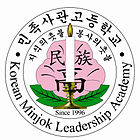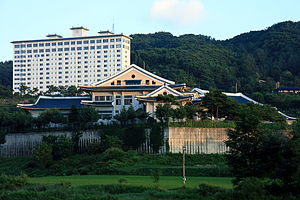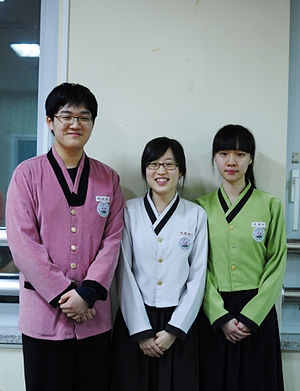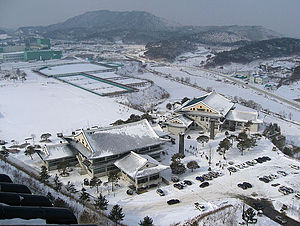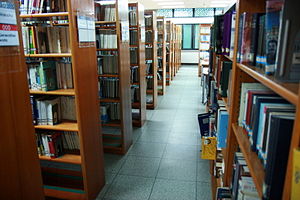- Korean Minjok Leadership Academy
-
Korean Minjok Leadership Academy
민족사관고등학교Location Hoengseong, Gangwon province, Republic of Korea Information Type Private Motto Deep Awareness of the Heritage of Our People (민족 주체성 교육)
Korea in Heart, World in Mind
Established 1996 Head of school Cheong-il Yoon, Ph.D. Faculty 67 (2010) Grades 10–12 Number of students 470 (2010) Student to teacher ratio 7:1 Campus Rural, 1,274,350 square metres (314.90 acres) Website English / Korean Korean Minjok Leadership Academy (Korean: 민족사관고등학교, Hanja: 民族史觀高等學校), also known as KMLA or Minsago (민사고), is a co-educational, independent boarding high school near the town of Hoengseong, Gangwon, South Korea, 120 kilometers (75 mi) east of Seoul at an elevation of 600 meters (1,900 feet). Located on 1.27 square kilometers (314 acres), it is one of the largest institutions in terms of contiguous area in the country. One of the most highly selective[1] and renowned[2] high schools in Korea; an application and examination consisting of four separate interviews is required of all students for admission.
Contents
Description
Some of KMLA's characteristics and policies are as follows:
- Support for the teachers' academic research;
- English-Only Policy, which requires every student and teacher to use English during the school hours, except in Korean language and Korean history classes;
- Individual college counseling for students regardless of field;
- Daily physical training (morning exercise) in forms of Taekwondo and Kumdo;
- Promotion of classes and clubs for Korean traditional music and arts, including Samul Nori, Daegeum, and Gayageum;
- Individual Research (IR) hours granted within the regular curricula;
- Unsupervised examination policy;
- Wide variety of clubs including athletic teams, orchestra, school bands, community service groups, student publications, craft workshop sessions, and peer tutoring.
The admission process of KMLA goes through three steps — a first round selection of students is admitted based on application forms containing school grades, essay, and extra curricular activities. Selected students then go through a writing test, an interview, and a physical test (4 km track); those who achieve generalized top evaluations are admitted.
Throughout school history, students of KMLA have received awards in international competition/Olympiads in science, mathematics, debating and philosophy. The average SAT scores for students enrolled in the international program in 2008 were critical reading, 654; math 786; writing 697 (total, 2137).[3]
Approximately half of the graduates enroll in foreign universities, mostly in the United States. The annual cost of attending KMLA is estimated to be $15,800 (2008).[4]
History
School founder Choi Myung-Jae found reason in establishing KMLA upon a visit to England's Eton College in 1977, feeling the need for an institution of high character to nurture future global leaders in Korea.
Mr. Choi received government permission to establish the school in 1993. The first Head Master and faculty were appointed on 1 March 1995, and the school received its first students a year later. The gym was completed in December of 1996, while Dasan Hall (one of the two main school buildings) was completed nearly a year later.
The school's `English-only policy' (EOP) was established in January of 1997 and was applied to all areas of the school except a few non-English classes. In February of the same year, Choi Myung-Jae was appointed as school director. In 1998, the school's three step education policy of `teaching-discussion-writing' was institutionalized, the first elections for the student council were held, and the Minjok Herald was first published. In 1999, the graduation for the first wave was held and the twelve-floor dormitory was built. In 2000, Choi Kyung-Jong was appointed director.
In 2001, the school was certified as an Educational Testing Service AP test center and designated as an experimental independent private school by the South Korean government, granting KMLA more freedom in school management than normally accorded to other heavily regulated South Korean private high schools. In 2002, the founder Choi Myung-Jae took office as the fourth Head Master. In 2003, the school held its first mathematics competition for middle school students and the former minister of education, Mr. Lee Don-Hee was appointed Head Master in August. In 2004, the school established an individual research program and became certified to administer the SAT and PSAT.
In 2007, KMLA was highlighted by the US College Board as a world best school in the Advanced Placement Program in seven subjects expanded from four subjects the year before—calculus, chemistry, microeconomics, macroeconomics, physics, and statistics. That same year, the Wall Street Journal listed the school's international program at No. 32 among schools that matriculated students to eight most-selective American colleges and universities.[2]
With the commencement of the new semester in 2008, Cheong-Il Yoon, Ph.D., former dean of education at Seoul National University, assumed the headmastership. Under his leadership, reforms have been initiated, namely the increased and systematized effort to fundraise as well as the plan to make foreign teachers comprise 30 percent of its faculty.
School life
All of KMLA students are either in the Minjok Field (domestic program) or the International Field, depending on their plans for college application. In 2002, for the first time, the school admitted more international program students than domestic program students. Beginning in 2008, KMLA has begun to select students without differentiation by separate tracks, enabling the students to make their decisions concerning college during their high school years without unnecessary pressure .
In the beginning years of KMLA, the entrance exam allowed only 20 to 30 passing students, but has steadily increased the number of new students from 2003. From 2004-2009, the school admitted 150 students. However, corresponding with the plans of the school to increase its size, an enrollment of around 160 students has marked the most recent entry of students into KMLA(2010).
Although the largest number of KMLA students are from Seoul and Gyeonggi-do, students come from all over the country, as far as Jeju. Moreover, numerous students from nations abroad, including China, Canada, France, Japan, and the United States, have been granted admission into the academy. Starting from 2008, half of students will be selected proportional to the population of their respective areas. This initiative is an effort to minimize the disadvantage some students face from limited financial resources.
Traditions
Uniforms
The uniforms of KMLA can be divided roughly into two groups. The most common uniform is a modernized hanbok. Students wear these to most classes and are free to choose from up to a dozen different colors for tops. There are also three seasonal variations for summer, winter, and spring/fall, varying in thickness, sleeve length, and fabric. All teachers also wear hanbok which they are free to choose in style and color. An alternative formal uniform exists for special occasions or school ceremonies following the more traditional hanbok.
Honjung
Honjung(Korean : 혼정, Hanja : 昏定) is a Korean traditional procedure during which scholars reflect on the day and pay gratitude to their parents. Honjung starts at 9:00 p.m and ends at 10:00 p.m in assembly rooms found in the dormitory. Since KMLA is a boarding school, students direct their thanks to the 'dorm parents', or dormitory supervisors, in proxy of their parents. The time is also used to make announcements and share celebratory events, such as a birthday. Once announcements are finished, all students bow to the dorm parents to end the Honjung. After Honjung, the school hands out snacks to the students.
Minjok Peer Tutoring
Minjok Peer Tutoring, or MPT, is a peer tutoring system in which students share their specific strengths with one another through one on one tutoring. The MPT program is designed to bring together students with strengths in different fields (math, science, humanities) to ensure a more rounded education of the entire student body. Students who wish to receive MPT register as "tutees" along with their desired subjects and the students who wish to teach register as "tutors" with their preferred subject to teach. Some students prearrange their lessons with their tutors, but for those who cannot, the MPT managers arrange the tutors and the tutees allowing efficient progress.
KMLA School Song
The school song is written in the form of sijo or Korean Folk Music. The school song consists of the school history and eventual goal of the school. Singing the song in morning assemblies and school events, students promote school pride and community spirit. Every Monday at the end of the morning assembly, all students and teachers stand up and sing the school song in Korean Folk Music version, accompanied by Minjok Orchestra.
Extracurricular Activities
Over a hundred extracurricular activities are available at KMLA. Examples include School Mock Trial club, Sock Sack Im (Peer-Counseling Club), Through the Lens (Photography Club), Daechita (Korean Traditional Music for Royal Palace Ceremonies & Rituals) , Samuchim ( Samul nori club), Minjok Orchestra (an intramural orchestra composed of both western and Korean traditional instruments), New Age of Ballad (a ballad group aka NAB), FITM and PLZ (rock bands), Rhyme Factory (a hip hop crew), the school branch of Amnesty International, student news publications (Minjok Herald in English and Bulhui in Korean), English Debating Society (an English debate club aka EDS), ECORUM (an economics forum club), Apple Pie (an astronomy club), Life is Drama (a Drama club), etc.
Student Clubs
- KMLA Orchestra
KMLA Orchestra is one of the two orchestras in Korean Minjok Leadership Academy. The orchestra has held several concerts at HoengSeong Community Center, Bobas Hospital, and Coex Mall.
- Through the Lens
Through the Lens, or TTL, is the only photography club in Korean Minjok Leadership Academy. The club has a website [1] to share members' photographies with KMLA students. Also, it holds inner-school exhibitions twice a year and outer-school exhibition once a year. In 2010, TTL's exhibition was reviewed by many notable Korean photographers.
- Minjokers
Minjokers is the baseball club in Korean Minjok Leadership Academy. About 10~15 students are picked each year through thorough evaluation. In 2010, they won gold in the Gangwon baseball championship.
- Cinabro
This club focuses on petitioning for rights for the Korean so-called "comfort-women" who were victimized by the Japanese in World War II. It also engages in public-awareness campaigns on the issue.
- Game Over
Gameover is the official girl's basketball team in KMLA. Gameover memebers have practice everyday during the weekdays, with an additional two hours practice twice every week. Under the instruction of Vice Principal Dr. Han, Gameover has won public acclaim and acknowledgement as the five time running Gangwon State Champion
- Cross Over
Like their counterparts, Crossover holds practices at least five days a week, and receives formal training from the coaching staff of a nearby professional league basketball team. Individual practice sessions are also strongly encouraged. It won the Gangwon State Championships in 2009, 2010, and the Gangwon State Club Basketball Championship in 2010.
- Daechita the historically
Daechita is traditional ensemble practicing the historically royal music of Korea, which was played just before the appearance of king. 9 members are accepted during freshmen year and perform Daechita Music at the beginning of all major ceremonies held in school, including graduation ceremony, freshmen-welcoming ceremony and official school festival.
- English Debate Society (EDS)
The club engages in English debates both in and out of the campus with motions chosen from a variety of topics. The members have represented Korea in the World Schools Debating Championships (WSDC) held annually. In 2009, a team won the European Schools Debating Championships (ESDC) tournament held in Germany. Recently, four members of the club have represented the school at the International Public Policy Forum (IPPF) and finished as Semifinalists. The tournament, hosted by the Bickel & Brewer Foundation and NYU, began with at least three hundred teams from over thirty countries and forty states.
- KREEN
KREEN is a student club devoted to environmental awareness campaigns. The club has held numerous campaigns on and off campus, against wasteful water usage and electricity. Under the motto, save energy save earth, the club works in cooperation with the Ministry of Environment.
- Minjok Herald
The official student English newsmagazine of Korean Minjok Leadership Academy, Minjok Herald is a quarterly publication with a website that provides bi-weekly updates on school news. An entirely student-run newsmagazine, Minjok Herald is a member of the National Scholastic Press Association.
- Mock Trial
In Spring 2010, the KMLA Mock Trial Team won the Mock Trial Global competition held by Handong International Law School, and went on to defeat Team Australia at the second annual Korea-Australia Mock Trial Friendly Match. Another team from KMLA placed first runner up at the annual Korea Mock Trial Association Summer Championship, co-hosted by Korea Mock Trial Association and Yale Law School. The team is to represent Korea at the Asia-Pacific Mock Trial tournament which is to be held in Saipan. The KMLA's Mock Trial Team has no particular coach or teacher to guide members.
Student council
The Student Council of KMLA consists of three main branches : The Executive, Legislative, and Judicial. The members are elected every semester by popular vote.
Executive branch
Legislative branch
Judicial branch
The school judicial branch consists of three members - one chief, two vice chiefs. The members of the judicial branch are chosen through student election each semester. The judicial branch manages the school court, where the students who violated the school regulation go every Thursday. The branch also tests the validness of students' defending speeches, which if true can be excused from punishment. The amount of penalty points the students receive from breaking the school regulation depends on the judicial branch's judgments. The judicial branch also cooperates with other two branchs, the executive branch and legislative branch, to help amend problems in school regulations or systems.
School campus
- Dormitory
The dormitory is a 12 story building including student rooms, study hall, a cafeteria and bakery. 3 students share one room with individual beds and desks.Rooms are connected with a hallway and share a common bathroom.
- Minjok Cultural Center
Minjok Cultural Center is the center of Korean cultural education. Learning Korean traditions including Daegum, Gayageum, and Samul nori, students establish their identity as proud Koreans.
- Education Building
Education Building consists of two buildings, which are Chungmu-building and Dasan-building (above two buildings being named in tribute to two prominent figures of Korean history). There are science labs, a library, auditorium, computer labs, recording studios and practice rooms, a dance studio, as well as the bulk of teachers' individual laboratories.
- Gymnasium
Gymnasium is a indoor sports building with a gymnastics room in the basement. Such facilities allow students to enjoy many sports, despite the isolated location of KMLA, such as basketball, table tennis, taekwondo, kendo, valley ball, etc.
- Korean Archery Field
Practicing Korean traditional sports archery in this field, students train sound body and sound mind and pride for their nation.
- English Education Building
Along with the English Only Policy, the English Education Building is solely devoted to English education. Many English teachers including several native speakers have laboratories in this building.
- Track Field
Track field has 400m track capable of international 2nd field and track event. Inside the track, there is a lawn soccer field with a few sprinklers. A tennis court and basketball court are located beside the track field.
Student life
All students live in the school dormitory which is a twelve-story building. Boys' rooms are from 1st to 5th floor and girls' rooms are from 6th to 9th floor. The 10th floor has both boys' rooms and teachers' rooms. The eleventh floor is a complete Study Hall while the twelfth floor has the cafeteria.
Students eat three meals a day in the cafeteria and every night snacks are provided to students, including bread (freshly baked each afternoon), cereal, and milk. Birthday celebrations are also held at night in the cafeteria, for which students can order cake from nearby bakeries.
Students go to a meeting called Honjung(Korean: 혼정, Hanja: 昏定) at 9 P.M. (for twelfth graders) and 9:15 (tenth and eleventh graders). Honjung is a Korean traditional procedure, during which scholars would have a time of self-reflection and bid their ancestors good night. During Honjung in KMLA, announcements are made to the students by the dorm parent, who leave after the students bid him/her a good night. Then, under the management of the chief or vice chief of the Executive Council of the student body, announcements are addressed to and by students. Occasionally, special birthday announcements are made; mini-performances are commonly performed to celebrate the birthday girl/boy.
Morning exercise starts at 6:30 AM, classes at 8:30 AM. Students travel from class to class, unlike most public Korean schools. Lunch starts at 12:30 PM and ends at 1:30PM. Afternoon classes start at 1:40PM and end at 5:30PM. Adviser time, where student meet with their mentors (advisers), starts before class and ends at 8:30AM. Dinner starts after 8th period and ends at 7:00PM when students start studying in their rooms, the cafeteria or the study hall. 1st self-study period ends at 9 and Honjung starts. The second self-study time starts at 10:00PM and ends at 11:50PM. Lights off is at 2:00 AM.
Athletics
Athletic activities KMLA offers are as follows:
- Korean Traditional Archery
- Badminton
- Baseball
- Basketball
- Boxing
- Equestrian
- Football (soccer)
- Golf
- Kumdo
- Rowing
- Softball
- Swimming
- Table tennis
- Taekkyon
- Taekwondo
- Tennis
- Volleyball
- Water polo
References
- ^ Dillon, Sam (2008-04-27). "Elite Korean Schools, Forging Ivy League Skills". New York Times. http://www.nytimes.com/2008/04/27/world/asia/27seoul.html?_r=1&pagewanted. Retrieved 2009-10-30.
- ^ a b Gamerman, Ellen (2006-01-04). "How the Schools Stack Up". Wall Street Journal. http://online.wsj.com/public/resources/documents/info-COLLEGE0711-sort.html. Retrieved 2008-07-28.
- ^ Finch, J., and Kim, S.-k., "Thinking locally, acting globally: Redefining traditions at the Korean Minjok Leadership Academy," Journal of Korean Studies 33, 124-149, 2009. (cited from p. 137)
- ^ "Ibid.," (Cost of attendance valued at KRW15,000,000, p.141; currency rate at time of article research, March 2008 was KRW947 = USD1)
External links
Categories:- Gangwon
- High schools in South Korea
- Educational institutions established in 1996
Wikimedia Foundation. 2010.

